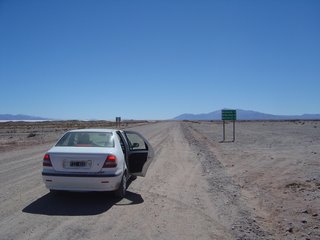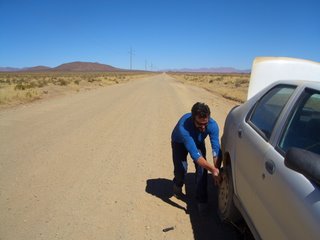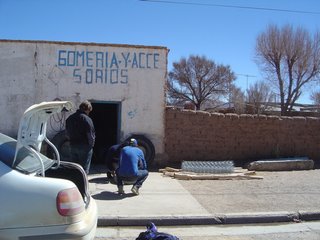A few weeks ago, I was driving Route 40 with an alternative energy wunderkind and one of the world’s leading experts on clams.

Route 40 is the longest highway in Argentina, traversing some 4700 kilometers at the feet of the Andes, from Río Gallegos, Santa Cruz Province, to the Bolivian border.
We were traveling in Jujuy, north from the Salinas Grandes to the town of Abra Pampa, a dusty settlement about 40km from the Bolivia. It is a well-kept road of dirt and gravel that cuts a straight line across the arid
puna (high desert). To the east lies a chain of foothills, to the west the salt flats glare beneath the Andes. Besides a few isolated homes and a mine, there is little beyond scrub, dry creek beds and alternating herds of llamas and wild burros along the way.
We were in no hurry, but my foot dropped steadily and the speedometer made a slow sweep right, until it bobbed around 110km/hr. I had to slow down to ease through the depressions caused by wash-outs, and occasionally the car would fishtail slightly when sand covered the surface of the road, but otherwise it was smooth going.

Between the desolate landscape and the steady spitting of gravel and dirt against the underside of the car, together with the plume of dust swirling in the rear-view mirror, there was something powerfully hypnotic about blasting down that empty road.
And then the tire popped.
We climbed out of the car, dust greeting us as we opened the doors. Thankfully there was a spare in the trunk, and we replaced the flat in no time.
Pierre, the alternative energy whiz, took the wheel and drove us to Abra Pampa at about half our previous speed. Since we were thinking of driving to a nearby lagoon to see flamingos, we decided that it would be wise to get a new spare. Luckily, no sooner than we pulled into town, we spotted a
gomería (tire shop).

The gomero confirmed what we suspected: the tire was beyond repair. For about $20 we bought a badly worn Firestone.
-Nice weather, isn’t it? –the gomero commented once the old new spare was in the trunk. Good small talk, a good way to start a story. It was typical weather he said and, in a few months time, when it was warmer, down the valley they’d be rounding up and branding cattle. And then he and his family would ride mules overnight all the way to Jujuy, to celebrate the festival of San Salvador. There was another festival in Iruya, just over the mountain range. The same mountain range over which the Spanish had come centuries before, the same range where the Yankees had dug their mine. Before the Spanish were the Incas.

-It’s always the same story, he said.
He told me of the bad grass that killed donkeys in the hillside and of the asados they had during roundup time. And a little later, the rainy season would begin, after which crops would be harvested.
Then he made a comment about the dry season, the wind, the dust clouds.
Somehow in thirty minutes he had told me the pattern of life in Abra Pampa from year to year and wove into it the history of the region.
And then he checked the air on our tires once more.
The other back tire was flat.
 Route 40 is the longest highway in Argentina, traversing some 4700 kilometers at the feet of the Andes, from Río Gallegos, Santa Cruz Province, to the Bolivian border.
Route 40 is the longest highway in Argentina, traversing some 4700 kilometers at the feet of the Andes, from Río Gallegos, Santa Cruz Province, to the Bolivian border. Between the desolate landscape and the steady spitting of gravel and dirt against the underside of the car, together with the plume of dust swirling in the rear-view mirror, there was something powerfully hypnotic about blasting down that empty road.
Between the desolate landscape and the steady spitting of gravel and dirt against the underside of the car, together with the plume of dust swirling in the rear-view mirror, there was something powerfully hypnotic about blasting down that empty road. The gomero confirmed what we suspected: the tire was beyond repair. For about $20 we bought a badly worn Firestone.
The gomero confirmed what we suspected: the tire was beyond repair. For about $20 we bought a badly worn Firestone.
 I have two of these things on my feet as I write.
I have two of these things on my feet as I write.